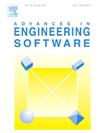Effect of frequency content of ground motion on seismic response of buildings with variable aspect ratio including soil-structure interaction
IF 5.7
2区 工程技术
Q2 COMPUTER SCIENCE, INTERDISCIPLINARY APPLICATIONS
引用次数: 0
Abstract
Soil-structure interaction (SSI) may lead to reduction, amplification or negligible change in structural responses depending on the relationship between the nature of excitations and subsoil conditions. Since neglecting SSI effects may cause uncertainties in seismic design, it is crucial to consider them during the design process. Another important factor affecting the dynamic behavior of structures interacting with the ground is the dynamic properties of the structures. To consider this effect, three buildings with 4, 8, and 12 stories designed in accordance with the Turkish Building Earthquake Code (TBEC-2018) are analyzed. The aspect ratios of these structures are 2, 4, and 6, corresponding to squat, ordinary, and slender structures, respectively. The primary objective of this study is to simulate the combined effects of these key parameters on the dynamic response of reinforced concrete structures. In the time history analyses, six ground motions classified by three different frequency contents are considered. 3D finite element models of SSI systems are established using ANSYS software. The usability of the numerical models is demonstrated for both SSI and fixed-base cases through three different analytical approaches. The displacement, acceleration, and stress responses are examined through time history analyses. The results indicate that the SSI is not negligible and neglecting the SSI is an oversimplification that does not lead to always-conservative predictions. Moreover, both the frequency content of the excitation and the structural aspect ratio are found to be decisive parameters in seismic response.
地震动频率含量对含土-结构相互作用变宽比建筑物地震反应的影响
土-结构相互作用(SSI)可能导致结构响应的减小、放大或可忽略不计的变化,这取决于激励性质和底土条件之间的关系。由于忽略SSI效应可能会在抗震设计中造成不确定性,因此在设计过程中考虑SSI效应至关重要。影响结构与地面相互作用动力性能的另一个重要因素是结构的动力特性。为了考虑这种影响,根据土耳其建筑地震规范(tbc -2018)对三栋分别为4层、8层和12层的建筑进行了分析。这些结构的纵横比分别为2、4和6,分别对应于深、普通和细长结构。本研究的主要目的是模拟这些关键参数对钢筋混凝土结构动力响应的综合影响。在时程分析中,考虑了按三种不同频率分量分类的六种地震动。利用ANSYS软件建立了SSI系统的三维有限元模型。通过三种不同的分析方法,证明了数值模型在SSI和固定基数情况下的可用性。位移、加速度和应力响应通过时间历史分析进行检验。结果表明,SSI是不可忽略的,忽略SSI是一种过度简化,不会导致总是保守的预测。此外,发现激励频率含量和结构长径比是地震反应的决定性参数。
本文章由计算机程序翻译,如有差异,请以英文原文为准。
求助全文
约1分钟内获得全文
求助全文
来源期刊

Advances in Engineering Software
工程技术-计算机:跨学科应用
CiteScore
7.70
自引率
4.20%
发文量
169
审稿时长
37 days
期刊介绍:
The objective of this journal is to communicate recent and projected advances in computer-based engineering techniques. The fields covered include mechanical, aerospace, civil and environmental engineering, with an emphasis on research and development leading to practical problem-solving.
The scope of the journal includes:
• Innovative computational strategies and numerical algorithms for large-scale engineering problems
• Analysis and simulation techniques and systems
• Model and mesh generation
• Control of the accuracy, stability and efficiency of computational process
• Exploitation of new computing environments (eg distributed hetergeneous and collaborative computing)
• Advanced visualization techniques, virtual environments and prototyping
• Applications of AI, knowledge-based systems, computational intelligence, including fuzzy logic, neural networks and evolutionary computations
• Application of object-oriented technology to engineering problems
• Intelligent human computer interfaces
• Design automation, multidisciplinary design and optimization
• CAD, CAE and integrated process and product development systems
• Quality and reliability.
 求助内容:
求助内容: 应助结果提醒方式:
应助结果提醒方式:


